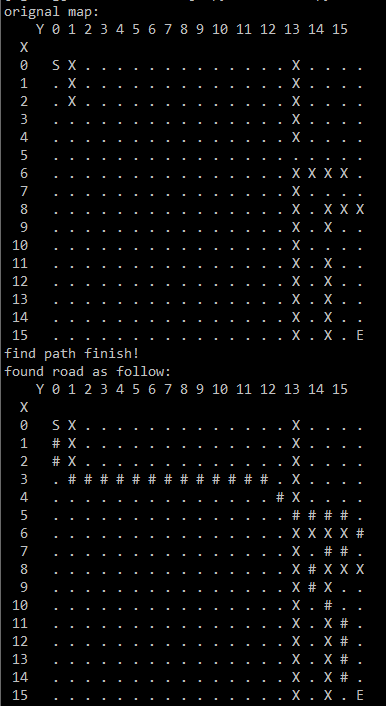A*(A星)演算法python實現
在春節放假前兩天我偶然看到了A*演算法,感覺挺有意思。正好放假前也沒有什麼事情,就花了一個下午寫出演算法的骨架,節後又花了半天時間完善螢幕輸出的細節並且除錯完成。
該實現只是一時興起的隨手而作,沒有考慮效能和擴充套件性等問題。正在學習A*的朋友可以拿去隨便折騰。
Email: [email protected]
程式碼的執行效果如下:
#!/usr/bin/python
# vim:set fileencoding=utf-8
# 在春節放假前兩天我偶然看到了A*演算法,感覺挺有意思。正好放假前
# 也沒有什麼事情,就花了一個下午寫出演算法的骨架,節後又花了半天 相關推薦
A*(A星)演算法python實現
在春節放假前兩天我偶然看到了A*演算法,感覺挺有意思。正好放假前也沒有什麼事情,就花了一個下午寫出演算法的骨架,節後又花了半天時間完善螢幕輸出的細節並且除錯完成。 該實現只是一時興起的隨手而作,沒有考慮效能和擴充套件性等問題。正在學習A*的朋友可以拿去隨便折騰
快速排序(quick sort)的Python實現
#!/usr/bin/env python # -*- coding: utf-8 -*- # @Time : 2018/8/11 12:59 AM # @Author : Blake import random def quick_sort(array):
1001 害死人不償命的(3n+1)猜想 Python實現
卡拉茲(Callatz)猜想:對任何一個自然數n,如果它是偶數,那麼把它砍掉一半;如果它是奇數,那麼把(3n+1)砍掉一半。這樣一直反覆砍下去,最後一定在某一步得到n=1。卡拉茲在1950年的世界數學家大會上公佈了這個猜想,傳說當時耶魯大學師生齊動員,拼命想證明這個貌似很傻很天真的命題,結果鬧得學生們無心學業
步步學習之用python實戰機器學習1-kNN (K-NearestNeighbors)演算法(a)
我最近才開始接觸機器學習,我大學數學學的幾乎忘了,最近才接觸python。所以我以一個完全初學者角度來學習機器學習。 我主要用的書籍就是machine learning in action (機器學習實戰)這本書。我主要是用文中已有的程式碼來講解機器學習。 同時對程式碼進行
PTA 陣列迴圈左移 (20 分) 本題要求實現一個對陣列進行迴圈左移的簡單函式:一個數組a中存有n(>0)個整數,在不允許使用另外陣列的前提下,將每個整數迴圈向左移m(≥0)個位置,即將a中的
陣列迴圈左移 (20 分) 本題要求實現一個對陣列進行迴圈左移的簡單函式:一個數組a中存有n(>0)個整數,在不允許使用另外陣列的前提下,將每個整數迴圈向左移m(≥0)個位置,即將a中的資料由(a0a1⋯an−1)變換為(am⋯an−
決策樹(ID3 C4,5 減枝 CART演算法)以及Python實現
演算法簡述 在《統計學習方法》中,作者的if-then的描述,簡單一下子讓人理解了決策樹的基本概念。 決策樹,就是一個if-then的過程。 本文主要學習自《統計學習方法》一書,並努力通過書中數學推導來
N數碼問題的啟發式搜尋演算法--A*演算法python實現
一、啟發式搜尋:A演算法 1)評價函式的一般形式 : f(n) = g(n) + h(n) g(n):從S0到Sn的實際代價(搜尋的橫向因子) h(n):從N到目標節點的估計代價,稱為啟發函式(搜尋的縱向因子); 特點: 效率高, 無回溯, 搜尋演算法 OPEN表 : 存放待擴充套件的節點. CLOS
機器學習實戰(第二篇)-k-近鄰演算法Python實現
上一篇幅中,我們介紹了k-近鄰演算法的基本概念、具體的分析步驟和分析方法,本篇中我們將介紹如何通過Python工具實現一個k-近鄰演算法。 1. 準備-使用Python匯入資料 首
【機器學習演算法-python實現】決策樹-Decision tree(1) 資訊熵劃分資料集
1.背景 決策書演算法是一種逼近離散數值的分類演算法,思路比較簡單,而且準確率較高。國際權威的學術組織,資料探勘國際會議ICDM (the IEEE International Con
機器學習經典演算法詳解及Python實現--線性迴歸(Linear Regression)演算法
(一)認識迴歸 迴歸是統計學中最有力的工具之一。機器學習監督學習演算法分為分類演算法和迴歸演算法兩種,其實就是根據類別標籤分佈型別為離散型、連續性而定義的。顧名思義,分類演算法用於離散型分佈預測,如前
聚類之均值聚類(k-means)演算法的python實現
# -*- coding: UTF-8 -*- import numpy import random import codecs import copy import re import matplotlib.pyplot as plt def calcuDistance(vec1, vec2):
K最近鄰演算法(KNN)---sklearn+python實現
def main(): import numpy as np from sklearn import datasets digits=datasets.load_digits() x=digits.data y=digits.target from sklear
(三)協同過濾演算法之基於物品的推薦演算法python實現
一、背景介紹 網際網路的迅猛發展將人類帶入了資訊社會和網路經濟時代,資訊化影響到了生活的方方面面。但是隨著網際網路產業的擴大,為使用者提供更多選的同時也帶來了篩選與推薦的難題。於是便提出了推薦演算法幫助使用者快速找到自己喜愛的東西。例如京東、淘寶、美團等
【機器學習演算法-python實現】KNN-k近鄰演算法的實現(附原始碼)
下載地址 kNN演算法及例項原始碼實現#coding=utf-8 ''' Created on Sep 16, 2010 kNN: k Nearest Neighbors Input: inX: vector to compare to existing dataset (1xN)
人臉識別演算法-特徵臉方法(Eigenface)及python實現
這幾天無聊,正好想起來以前誰說有同學做人臉識別,感覺好高大上,所以找來一些基礎的人臉識別演算法來自己實現一下,正好鍛鍊一下numpy的使用。 特徵臉方法基本是將人臉識別推向真正可用的第一種方法,瞭解一下還是很有必要的。特徵臉用到的理論基礎PCA我在這裡就不說了,百度一大
鳶尾花三種聚類演算法(K-means,AGNES,DBScan)的python實現
一.分散性聚類(kmeans) 演算法流程: 1.選擇聚類的個數k. 2.任意產生k個聚類,然後確定聚類中心,或者直接生成k箇中心。 3.對每個點確定其聚類中心點。 4.再計算其聚類新中心。 5.重複以上步驟直到滿足收斂要求。(通常就是確定的中心點不再改變。
基本A*演算法python實現
# -*- coding: utf-8 -*-import math#地圖tm = ['############################################################','#...............................................
TF-IDF演算法-Python實現(附原始碼)
一、背景 TF-IDF演算法全稱 termfrequency–inverse document frequency,是一種用於資訊檢索與資訊探勘的常用加權技術。它的演算法複雜度並不高,但能很好的滿足搜尋高相關度文件的需求。由於它的高效性,TF-IDF 模型在搜尋引擎等實際應用中被廣泛使用
SVM支援向量機-《機器學習實戰》SMO演算法Python實現(5)
經過前幾篇文章的學習,SVM的優化目標,SMO演算法的基本實現步驟,模型對應引數的選擇,我們已經都有了一定的理解,結合《機器學習實戰》,動手實踐一個基本的SVM支援向量機,來完成一個簡單的二分類任務。建立模型之前,首先看一下我們的資料,然後再用支援向量機實現分類:
資料探勘入門系列教程(五)之Apriori演算法Python實現
資料探勘入門系列教程(五)之Apriori演算法Python實現載入資料集獲得訓練集頻繁項的生成生成規則獲得support獲得confidence獲得Lift進行驗證總結參考 資料探勘入門系列教程(五)之Apriori演算法Python實現 在上一篇部落格中,我們介紹了Apriori演算法的演算法流

